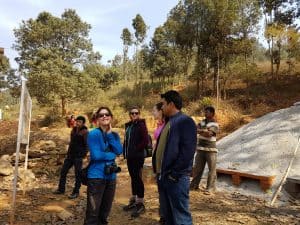Contributed by Amy Carter

Trekkers at construction site in Nepal
Having just returned from the RMS Impact Trek in Nepal I felt encouraged to write about the tremendous work which Build Change is doing following the devastating earthquake in April 2015. My awareness of the charity only really came to light when RMS announced they would be organizing the impact trek and choosing three clients to take with them. I was lucky enough to be one of those three. But this fact has also resonated how lesser known the charity is, especially in the insurance sector in which we work.
Given my naivety, my assumption of Build Change was rather simplistic. Typically in the relief efforts following a natural disaster, international agencies respond by reconstructing buildings and critical infrastructure which has been destroyed in a catastrophic event. What often happens in these situations however is that the decisions and reconstruction efforts are determined by these external agencies and often rarely involve the people who are going to live there. A further issue arises where international agencies have a much wider access to resource and where their construction practices may not necessarily be sustainable once the international funding comes to an end. This issue is further inflated in countries like Nepal whose varied and extreme terrain requires a much more diverse consideration for culture and building practices.
Build Change’s vision is much more holistic and focuses on building resilience by working at the local home-owner level, using local materials, local resource and local capability. The charity seldom builds constructions for homeowners (only in instances where on-the-job training can be incorporated) but rather works alongside them assisting with the technical expertise and knowledge required to build earthquake resistant structures in the rural and often isolated villages of the Kathmandu valley. Further to building new constructions, Build Change actively promotes retrofitting partially damaged homes. This is hugely important for home-owners who do not have the capacity to finance a new construction and is something which the Nepalese government does not currently consider. What was also incredibly impressive to see, was the knowledge and expertise of the Nepali structural engineers employed at Build Change. We were kindly invited to the engineering lab at Kathmandu University to see how they stress test these retrofit designs before they are implemented in the field. This academic involvement provides confidence in this new retrofit concept for Nepal.

Testing lab at university in Kathmandu
Build Change is making a remarkable difference in building resilience. Being engaged at the local level is extremely effective and is enabling permanent change which can be sustained. But to scale this up to a national (or even international) level is probably the most difficult to achieve and involves working with the government to enforce building codes or altering the current vulnerable building practices. A further challenge which Build Change highlighted was the lack of Insurance penetration in Nepal. The insurance industry provides a vital role in development and this is a well known concept in the development community. But providing the right financing and risk transfer mechanisms is often difficult and lacks the traction it needs to get it off the ground. But with the right thought and consideration I’m sure this issue can be solved and would be a huge achievement across the developing network. I hope that raising this awareness and the work of Build Change can go some way towards this solving this issue.
